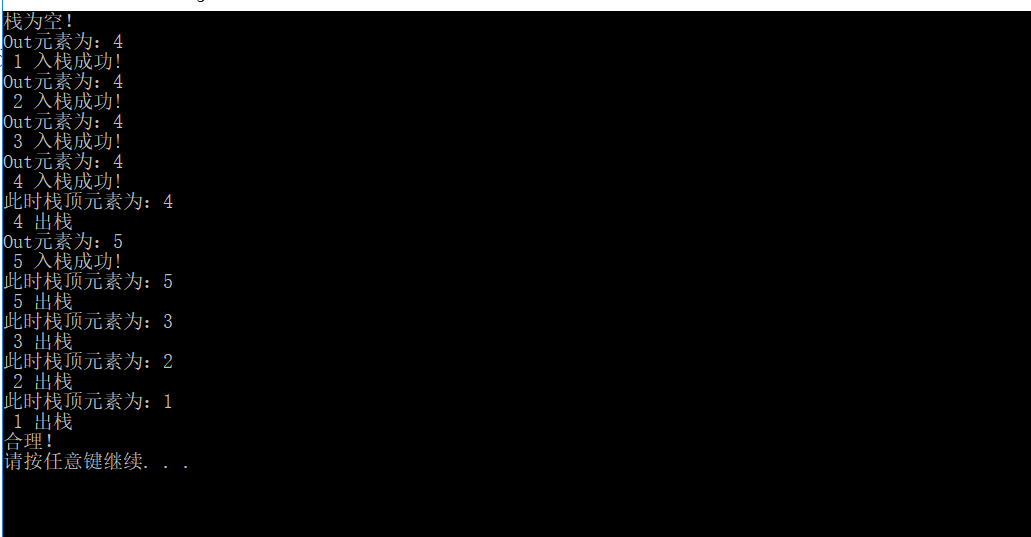使用两个栈实现一个队列:
如图所示数据入栈,队列是队尾进数据,队头删数据,而在栈中,我们无法在对头删除数据,因此,需要把S1里的n-1个数据放到S2中,然后删除S1中的数据,在将S2中的数据放回到S1中。

stack.c
#include"stack.h"
void stackinit(stack *s)
{
assert(s);
s->_size = 0;
}
void stackpush(stack *s, DataType data)
{
assert(s);
if (s->_size == MAX_SZIE)
return;
s->_arr[s->_size] = data;
s->_size += 1;
}
void stackpop(stack *s)
{
assert(s);
if (s->_size == 0)
return;
s->_size -= 1;
}
DataType stacktop(stack *s)
{
assert(s);
if (s->_size == 0)
exit(0);
return s->_arr[s->_size - 1];
}
void stackprint(stack *s)
{
int i = 0;
assert(s);
if (s->_size == 0)
return;
for (i = 0;i < s->_size;i++)
{
printf("%d-> ",s->_arr[i]);
}
printf("\n");
}
//////////////////////////////////////
void queuestackinit(queuestack *s)
{
assert(s);
stackinit(&s->s1);
stackinit(&s->s2);
}
void queuestackpop(queuestack *s)
{
int i = 0;
assert(s);
while(s->s2._size)
{
stackpush(&s->s1,stacktop(&s->s2));
stackpop(&s->s2);
}
while(s->s1._size > 1)
{
stackpush(&s->s2,stacktop(&s->s1));
stackpop(&s->s1);
}
printf("%d->",stacktop(&s->s1));
stackpop(&s->s1);
}
void queuestackpush(queuestack *s, int data)
{
assert(s);
if (s->s1._size == MAX_SZIE)
return;
stackpush(&s->s1,data);
}
stack.h
#include<stdlib.h>
#include<assert.h>
#define MAX_SZIE 10
typedef int DataType;
typedef struct stack
{
DataType _arr[MAX_SZIE];
int _size;
}stack;
typedef struct minstack
{
struct stack s1;
struct stack s2;
}queuestack;
void stackinit(stack *s);
void stackpush(stack *s, DataType data);
void stackpop(stack *s);
DataType stacktop(stack *s);
void stackprint(stack *s);
//////////////////////////////////////
void queuestackinit(queuestack *s);
void queuestackpop(queuestack *s);
void queuestackpush(queuestack *s, int data);
test.c
#include"stack.h"
test()
{
queuestack s;
queuestackinit(&s);
queuestackpush(&s, 1);
queuestackpush(&s, 2);
queuestackpush(&s, 3);
queuestackpush(&s, 4);
queuestackpush(&s, 5);
queuestackpush(&s, 6);
queuestackpop(&s);
queuestackpop(&s);
queuestackpop(&s);
queuestackpop(&s);
queuestackpop(&s);
queuestackpop(&s);
}
int main()
{
test();
system("pause");
return 0;
}
2:使用两个队列实现一个栈
H
#pragma once
#include<stdio.h>
#include<stdlib.h>
#include<assert.h>
#define MAX_QUEUE 100
typedef int DataType;
typedef struct queue
{
DataType _arr[MAX_QUEUE];
int _front;
int _rear;
}queue;
typedef struct stack
{
struct queue q1;
struct queue q2;
}stack;
void queue_init(queue *q);//初始化
void queue_en(queue *q, DataType data);//入队列
void queue_de(queue *q);//出队列
int queue_Empty(queue *q);//队列判空
get_head(queue *q);//获取队头元素
void queue_print(queue *q);
//////////////////////////////////////////////
void stackqueue2init(stack *q);
void stackqueue2push(stack *q,DataType data);
void stackqueue2pop(stack *q);
void stackqueue2top(stack *q);
int stackqueue2empty(stack *q);
C
#include"stackqueue2.h"
void queue_init(queue *q)
{
//构造一个空队列
q->_front = q->_rear = 0;
printf("初始化已完成!\n");
}
void queue_en(queue *q, DataType data)
{
if (q->_rear == MAX_QUEUE)
{
printf("队列已满!\n");
return;
}
q->_arr[q->_rear] = data;
q->_rear += 1;
}
void queue_de(queue *q)//出队列
{
if (!queue_Empty(q))
{
printf("队列为空!");
return;
}
q->_front += 1;
}
int queue_Empty(queue *q)
{
if (q->_front == q->_rear)
{
return 0;
}
return 1;
}
int get_head(queue *q)//获取队头元素
{
if (!queue_Empty(q))
{
printf("队列为空");
return;
}
return q->_arr[q->_front];
}
void queue_print(queue *q)
{
int i = 0;
if (q->_front == q->_rear)
{
printf("队列为空!\n");
return;
}
printf("开始打印:\n");
for (i = q->_front;i<q->_rear;i++)
{
printf("%d ", q->_arr[i]);
}
printf("\n");
}
//////////////////////////////////////
void stackqueue2init(stack *q)
{
assert(q);
queue_init(&(q->q1));
queue_init(&(q->q2));
}
void stackqueue2push(stack *q, DataType data)
{
assert(q);
queue_en(&(q->q1), data);
}
void stackqueue2pop(stack *q)
{
assert(q);
if (stackqueue2empty(q))
{
printf("队列为空!!!");
return;
}
else
{
if (q->q2._front == q->q2._rear)
{
while (q->q1._front +1 != q->q1._rear)
{
queue_en(&q->q2,get_head(&q->q1));
queue_de(&q->q1);
}
printf("%d->",get_head(&q->q1));
queue_de(&q->q1);
}
else
{
while (q->q2._front + 1 != q->q2._rear)
{
queue_en(&q->q1, get_head(&q->q2));
queue_de(&q->q2);
}
printf("%d->", get_head(&q->q2));
queue_de(&q->q2);
}
}
}
int stackqueue2empty(stack *q)
{
assert(q);
if (queue_Empty(&q->q1) && queue_Empty(&q->q2))
{
return 1;
}
return 0;
}
void stackqueue2top(stack *q);
int main()
{
stack q;
stackqueue2init(&q);
stackqueue2push(&q, 1);
stackqueue2push(&q, 2);
stackqueue2push(&q, 3);
stackqueue2push(&q, 4);
stackqueue2push(&q, 5);
stackqueue2pop(&q);
stackqueue2pop(&q);
stackqueue2pop(&q);
stackqueue2pop(&q);
stackqueue2pop(&q);
system("pause");
return 0;
}
3 判断入栈顺序的合法性
h
void InOutisvalid(Stack *S,int *Inorder,int Insize,int *Outorder,int Outsize);
c
void InOutisvalid(Stack *S,int *Inorder,int Insize,int *Outorder,int Outsize)
{
int In = 0;
int Out = 0;
while (Out < Outsize)
{
while (StackEmpty(S) || StackTop(S) != Outorder[Out])
{
StackTop(S);
printf("Out元素为:%d\n", Outorder[Out]);
if ((In < Insize))
{
StackPush(S, Inorder[In++]);
}
else
{
printf("不合理!\n");
return;
}
}
printf("此时栈顶元素为:%d\n", S->_arr[S->_top]);
StackPop(S);
Out += 1;
}
printf("合理!\n");
}
test
test()
{
Stack S;
StackInit(&S);
int Inorder[] = {1,2,3,4,5,};
int Outorder[] = {4,5,3,2,1};
int Insize = sizeof(Inorder) / sizeof(Inorder[0]);
int Outsize = sizeof(Outorder) / sizeof(Outorder[0]);
InOutisvalid(&S,&Inorder,Insize,&Outorder, Outsize);
}
int main()
{
test();
system("pause");
}



